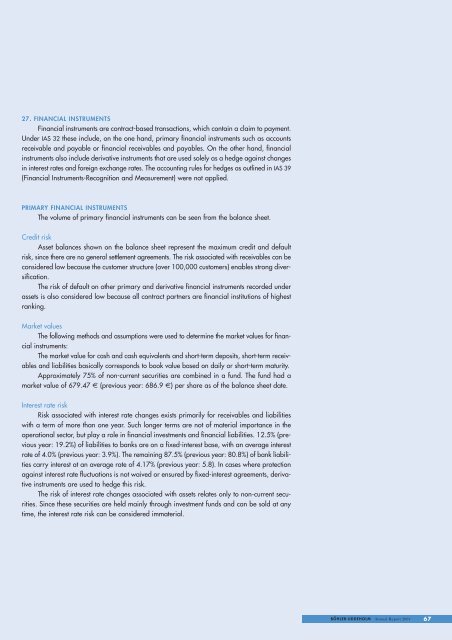Annual Report 2001 - Bohler Uddeholm materializing visions
Annual Report 2001 - Bohler Uddeholm materializing visions
Annual Report 2001 - Bohler Uddeholm materializing visions
Create successful ePaper yourself
Turn your PDF publications into a flip-book with our unique Google optimized e-Paper software.
27. FINANCIAL INSTRUMENTS<br />
Financial instruments are contract-based transactions, which contain a claim to payment.<br />
Under IAS 32 these include, on the one hand, primary financial instruments such as accounts<br />
receivable and payable or financial receivables and payables. On the other hand, financial<br />
instruments also include derivative instruments that are used solely as a hedge against changes<br />
in interest rates and foreign exchange rates. The accounting rules for hedges as outlined in IAS 39<br />
(Financial Instruments-Recognition and Measurement) were not applied.<br />
PRIMARY FINANCIAL INSTRUMENTS<br />
The volume of primary financial instruments can be seen from the balance sheet.<br />
Credit risk<br />
Asset balances shown on the balance sheet represent the maximum credit and default<br />
risk, since there are no general settlement agreements. The risk associated with receivables can be<br />
considered low because the customer structure (over 100,000 customers) enables strong diversification.<br />
The risk of default on other primary and derivative financial instruments recorded under<br />
assets is also considered low because all contract partners are financial institutions of highest<br />
ranking.<br />
Market values<br />
The following methods and assumptions were used to determine the market values for financial<br />
instruments:<br />
The market value for cash and cash equivalents and short-term deposits, short-term receivables<br />
and liabilities basically corresponds to book value based on daily or short-term maturity.<br />
Approximately 75% of non-current securities are combined in a fund. The fund had a<br />
market value of 679.47 € (previous year: 686.9 €) per share as of the balance sheet date.<br />
Interest rate risk<br />
Risk associated with interest rate changes exists primarily for receivables and liabilities<br />
with a term of more than one year. Such longer terms are not of material importance in the<br />
operational sector, but play a role in financial investments and financial liabilities. 12.5% (previous<br />
year: 19.2%) of liabilities to banks are on a fixed-interest base, with an average interest<br />
rate of 4.0% (previous year: 3.9%). The remaining 87.5% (previous year: 80.8%) of bank liabilities<br />
carry interest at an average rate of 4.17% (previous year: 5.8). In cases where protection<br />
against interest rate fluctuations is not waived or ensured by fixed-interest agreements, derivative<br />
instruments are used to hedge this risk.<br />
The risk of interest rate changes associated with assets relates only to non-current securities.<br />
Since these securities are held mainly through investment funds and can be sold at any<br />
time, the interest rate risk can be considered immaterial.<br />
BÖHLER-UDDEHOLM <strong>Annual</strong> <strong>Report</strong> <strong>2001</strong> 67




